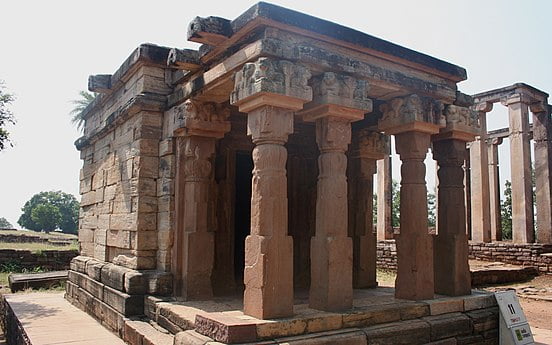Gupta Dynasty: The Golden Age Of India

The reign of Gupta emperors represents an era of ancient Indian history in which unprecedented progress was made in every sphere of civilization and culture and Hindu culture reached its culmination. Keeping in mind the all-round progress of the Gupta period, historians have named this period as ‘Golden Age’ or it is called the golden age of India. This period has also been known by the names ‘classical era’ or ‘pericline age of India’.
Gupta Era: The Golden Age Of India:
BC 185 When the Mauryan Empire collapsed in the ancient period, many small states were formed all over India. After this, these states kept fighting with each other for about 500 years. A king named Chandragupta established his kingdom in North India in 320 CE. This king, looking forward-looking, adopted many good things of the Mauryan Empire and set a good example for his next generation.
The reign of this king’s generation is known as the Gupta era. During this period India witnessed the rule of many great kings, such as Samudragupta and Chandragupta-2. All Gupta kings promoted the development of creativity, art, and literature.

The Etymology Of Gupta Dynasty:
Historians believe that tracing the history of India shows that in 185 BCE India was divided into very small pieces. At that time, the Mauryan Empire was declining and the Kushan and Satavahana dynasties were also unable to return the stability of India. As the feudatories of the Kushan dynasty, the Gupta dynasty started their political journey from the states of Uttar Pradesh and Bihar.
After this, the Gupta rulers were successful in establishing their rule over Magadha, through the middle Ganges, Prayag, and Ayodhya. The founder of the Gupta dynasty is believed to be Shreegupta and was succeeded by his son Ghatotkacha. But the Sun of the Gupta dynasty was transported to high altitudes by Chandragupta I. For this reason, Chandragupta also received the title of Maharajadhiraja.
Reason Behind The Golden Age Of India:
In the Gupta dynasty, the sunlight of Indian civilization and culture was at its peak. The following proofs can be presented as a symbol of this:
Best Governance System:
The secret regime was based on the monarchical system in which the successor inherited the rule. Due to the smooth running of this system, the Gupta empire extended from the Himalayas in the north to Vindhyaparvat in the south and from the standing of Bengal to Saurashtra in the east.
Apart from this, the entire government system was divided from the country unit to the village unit, due to which it was easy to govern at every level. Due to the establishment of political unity, stability was established at every level in the Gupta dynasty.
Economic Prosperity:
The prosperity of any country consists of the revenue or taxes collected in it. Its ruler Samudragupta was also known as Kubera due to the income derived from taxes in the Gupta dynasty. At this time, not only was the tax system strong, but the king had authority over other sources of income such as land revenue and property obtained through lands such as gems, mines, salt, and hidden treasures.
Recommended Articles :-
1000 Years Old Temples In India | Ancient Temples
Food Processing Industry In India | Know In Details
Aryabhatta Inventions: The Greatest Mathematician
How To Identify Plastic Rice From Real Rice
Top 10 States Which Are Largest Producer Of Rice In India
Largest Stadium In India | Largest Cricket Stadium
Trade & Commerce:
Trade and commerce are considered to be the backbone of any country. Various cities of Central and North India in the Gupta Empire such as Ujjain, Bharuch, Pratishthan, Vidisha, Prayag, Pataliputra, Vaishali, Tamralipi, Mathura, Ahichhatra, Kaushambi, etc. were known as famous trading centers.
Ujjain was very important in all these states because this country was not only well connected by the foreign route. Gold reserves were always full due to excess exports.
Religious Balance:
The spirit of all-religion reverence prevailed in the Gupta period. With the revival of Brahmin and Hinduism, Shaivism and Vaishnavism were equally strong.
Art And Culture:
The Gupta period is also called the Golden Age of art, literature, culture, and architecture. The Gupta temples are still considered the symbol of architecture of the High Court.
The caves of Ajanta-Ellora are unique specimens of the painting and various gems of literature are from the Gupta period itself. The writings of litterateurs like Kalidas, Aryabhata, and Varahamiri are still considered relevant.
Science And Technology:
Aryabhata was the scientist and mathematician of this era who, on the one hand, calculated the radius of the Earth and established new dimensions in the field of geography.
On the other hand, in the universe, a new theory was proposed by describing the sun as the center of the center. His equivalent Varahamiri had tried to give a new form to the society by starting the lunar calendar.
Epilogue:
It is said that a person is made from society and society is a nation. Due to this rule, while every person of the society was happy and prosperous on the one hand, in the Gupta dynasty, arts and science had the same honor and prestige. This is considered the identity of India’s Golden Age.
The Conclusion:
This article tells us why the Gupta period in Indian history is called the ‘Golden Age of India’. During the Gupta Empire, there was development in the fields of science, mathematics, astronomy, religion, etc. in India.
Not only this but the peace, development, and prosperity that took place in the country at that time, is a witness to this fact.
